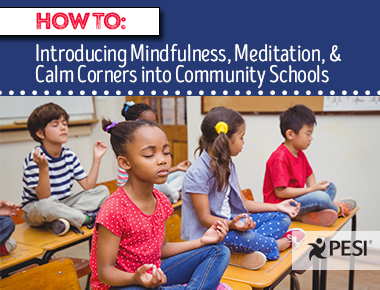Introducing Mindfulness, Meditation, and Calm Corners into Community Schools

More and more schools are witnessing the benefits of bringing mindfulness practices into education as a strategy for promoting social and emotional learning among students and for replacing overly harsh (so-called “zero tolerance") disciplinary policies with alternatives that teach and apply new skills.
Mindfulness is the moment-to-moment awareness of thoughts, emotions, and sensations in the internal and external environment. Based on ancient and classical yoga and meditation techniques, mindfulness is practiced to offset stress and bring us into lasting, positive relationships with ourselves and others. In the 1990s, mindfulness was widely introduced into health settings and, more recently, into schools. When applied systematically and imbedded in the daily schedule, mindfulness can transform toxic stress into a thriving culture, an oasis in the chaos. Simply put, tools such as breathing and watching thoughts come and go non-reactively bypass the rational, thinking mind, and target the nervous system. Regular practice allows us to go beyond hardwired fight, flight, or freeze responses. Habits and feelings like fear, anxiety, and worry are dissipated and released. As our minds become clear, we are better able to focus on healthy interactions and learning.
Community schools are ideal settings for implementing best practices in areas of self-regulation, social-emotional learning, and conflict resolution. Community schools are places where counselors, social workers, group leaders, peer mentors, teachers, and other content experts may have already set up balance centers, yoga or “chill” rooms, or just a quiet corner in the library or art room. Designated staff may have been trained in conflict resolution or yoga.
Many schools have engaged in best practices to promote resiliency and positive behaviors, and eliminate detention. Examples include “breathing buddies,” “peace puppets,” and intentional decision making. All young people need smooth transitions and a variety of strategies to learn and be at their best. Mindfulness research and practice show us that adults (teachers, parents, youth workers) need this too. Start with yourself.
Here are some tips, drawing on instructions and 50 easy-to-use strategies from My Calm Place: Yoga, Mindfulness and Meditation Strategies for Children. The cards are divided into four categories to:
- Calm, energize, or focus (meditation)
- Improve social-emotional learning and communication (connection)
- Release stress and enhance creativity (imagination)
- Promote sensory integration, body smarts or fitness (movement)
Each card is a quick and playful distillation of an evidence-based, mindful, heartfelt, behavioral, or physical “state changer” practice. Just pick one, and if it appeals to you, try it out. After you are comfortable with and engaged in your own practice, it’s time to spread the calm.
How to Start: Creating or Enhancing your Oasis of Calm or Quiet Corner
- Set up “My Calm Place” cards in a basket or on a shelf with similar materials.
- Take the lead, with a colleague if you can, in bringing in your knowledge or training. Or, hire an outside consultant or trainer to get the ball rolling. One or two train-the-trainer sessions may be all that’s needed.
- Work with creative staff to design or enhance your Balance Center or Quiet Corner. Yoga mats, pillows, cushy chairs and balls, dim lighting, soft music, and student input can be included.
Mini-breaks Training: Dive in and play with the practices
If you’re ready to bring a mindful approach to work right away, design a workshop or professional development for your colleagues. Use the “My Calm Place” card deck like a game, with different people taking turns choosing cards. After doing one or two experiences, ask questions such as:
- How did this one make you feel? (self-regulation)
- How would you apply it with your students/youth? (social interaction)
- How would you use this to extend or transition into a learning activity? (link to learning)
Examples:
- The Imagination card “Look Quietly” can precede an art or drawing activity.
- The Meditation card “Do Nothing” can be done anywhere when you or your group are tired.
- “Wave Breath” can precede a swimming or sports session.
- The verbal and nonverbal Connection cards (“Time to Speak,” “Speak from Your Heart,” and “Choose Your Words”) reinforce listening and speaking skills.
- Movement cards incorporate simple yoga and movement techniques and can be modified to meet special needs.
- Be creative and make your own activities on the four blank cards


